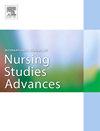Anaesthetic emergence agitation in adults following general surgery: A scoping review
IF 3.1
Q1 NURSING
International Journal of Nursing Studies Advances
Pub Date : 2025-03-18
DOI:10.1016/j.ijnsa.2025.100320
引用次数: 0
Abstract
Background
Anaesthetic emergence is the patient's transition from general anaesthetic until they are alert and in full control of vital reflexes. It is during this transition that significant complications, including anaesthetic emergence agitation, may occur. A preliminary search did not identify any research investigating adults who undergo anaesthetic emergence in critical care settings.
Objectives
To map the post-anaesthetic literature reporting outcomes, risk factors, and management of adult patients admitted directly to a critical care unit, who develop emergence agitation, and to describe the implications for clinical practice.
Methods
The scoping review was registered at https://osf.io/spwx5/ and conducted using the Joanna Briggs Institute methodology, with the framework of Population, Concept and Context. Search terms including agitation, anaesthetic, emergence, postoperative and surgery.
Results
Twenty-five articles were identified and were eligible for data extraction. Risk factors included co-morbid conditions, anaesthetic agents and the presence of in-situ invasive devices. Studies varied regarding design and patient assessment tools. Data were reported from one or more of eight observation timepoints along the emergence continuum, from end-anaesthetic until post anaesthetic care unit discharge. No studies investigated patients with direct postoperative admission to critical care settings.
Conclusions
This review has characterised the emergence continuum. The variations between studies has highlighted the necessity to reach future consensus regarding emergence definition and measurement. A critical gap was identified regarding recommendations for prevention and management of emergence agitation for patients admitted directly to a critical care unit.
普通手术后成人麻醉出现躁动:范围回顾
背景:麻醉苏醒是指患者从全身麻醉过渡到清醒并完全控制重要反射的过程。正是在这一转变过程中,可能出现显著的并发症,包括麻醉出现时的躁动。初步调查没有发现任何调查在重症监护环境中接受麻醉急救的成年人的研究。目的绘制直接入住重症监护病房的成年患者出现突发性躁动的麻醉后结果、危险因素和管理的文献,并描述其对临床实践的影响。方法范围审查在https://osf.io/spwx5/上注册,并使用乔安娜布里格斯研究所的方法,在人口,概念和背景的框架下进行。搜索词包括躁动,麻醉,急救,术后和手术。结果共鉴定出25篇文献,符合数据提取条件。危险因素包括合并症、麻醉剂和原位侵入装置的存在。研究在设计和患者评估工具方面各不相同。从麻醉结束到麻醉护理单位出院,从急诊连续体的八个观察时间点中的一个或多个报告数据。没有研究调查术后直接入住重症监护病房的患者。结论本综述描述了出现连续体的特征。研究之间的差异突出了在出现定义和测量方面达成未来共识的必要性。对于直接入住重症监护病房的患者的紧急躁动的预防和管理建议,发现了一个严重的差距。
本文章由计算机程序翻译,如有差异,请以英文原文为准。
求助全文
约1分钟内获得全文
求助全文
来源期刊

International Journal of Nursing Studies Advances
Nursing-General Nursing
CiteScore
5.80
自引率
0.00%
发文量
45
审稿时长
81 days
 求助内容:
求助内容: 应助结果提醒方式:
应助结果提醒方式:


